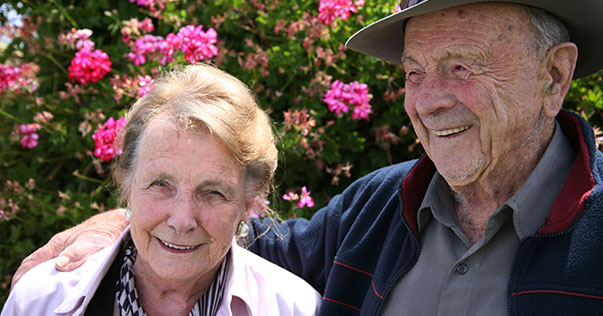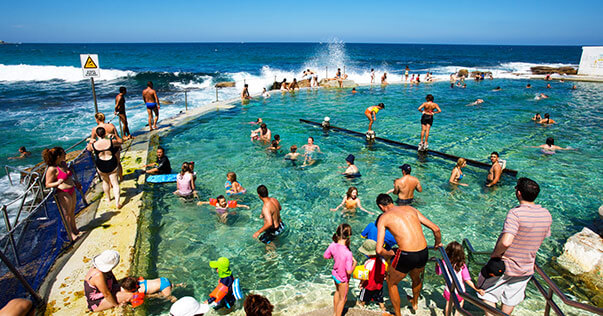AUSTRALIA TODAY
THE WAY WE LIVE NOW
Australia, your numbers are in.
The results of our latest national Census reveal who we are, where we live, what we do, how we work and how we lead our lives.
The information we've gathered will inform planning and decision-making for our future – decisions about where we build schools and roads and hospitals; about how we care for our most vulnerable citizens; about where we need funding and services across every community in Australia.
So here is the story of our nation – a living biography we get to update once every five years.
2016 Census: It's our data, and our future.

The population of Australia is 24.4 million
While the Census counted 23,401,892 people in Australia, the exact figure moves by the day due to births, deaths and international migration. As of August 2016, the Census revealed there were quite a few more of us than five years ago – 1,894,175 to be precise. That’s about 1,037 extra Aussies every day since the 2011 Census.
Put another way, we’ve grown since the 2011 Census by roughly the same amount as Adelaide, Canberra and Hobart’s total population combined in 2016.
While we’re outside the top 50 countries by population, we’re number six in land area (about 7.5 million km˛) – giving us each a little more than 3 km˛. Both China and India have more than 50 times our population, whereas we have five times the population of New Zealand or Ireland.
Our first state, New South Wales, remains our most populous (seven million) but it’s not growing as quickly as other states and territories (8.1% since 2011).The Australian Capital Territory, Victoria and Western Australia all grew by 11% between 2011 and 2016.
Our eastern mainland is still where most Australians call home, with almost eight in 10 people living in New South Wales, Victoria, Queensland and the Australian Capital Territory. Plenty of us – seven in 10 of us in fact – live in our capital cities. While the population of Australia has grown by close to 18% in this time, the populations of our cities have grown by a lower percentage – 11%.
That old Sydney versus Melbourne thing? It’s still the Harbour City with 4.8 million, but at 4.4 million, Melbourne is closing fast.
The Australian cities that are growing include Darwin (14%), Melbourne (12%) and Perth (12%).
However, not all our cities are growing at this pace. Those that have experienced the least amount of growth since the 2011 Census were Hobart (5.1%), Adelaide (5.8%), Brisbane (10%) and Sydney (10%).
Australia is much more than a collection of big cities. Alice Springs, our ‘biggest little town’, has a population of 24,753 ; Kalgoorlie, Australia’s largest outback city is home to 13,937. people; and iconic Birdsville – a population of just 115 people at the 2006 Census, now has 140 people.
Norfolk Island joined the Australian Census for the first time in 2016, adding 1,748 to our population.

85 is the new 65
Australia’s once youthful population is ageing slowly. Our median age is now 38. It was 23 in 1911, 28 in 1966, and 37 in 2011.
As our baby-boomer generation ‘matures’, we find that one in six of us are now over 65, compared to one in seven in 2011 and only one in 25 in 1911.
The greying of Australia continues, with 84,000 more people aged 85 years and older than in the 2011 Census. Today, people who are 85 years and older comprise 2.1% of our usual resident population.
More of us are surviving well into old age, thanks to improvements in diet, public health and medical technology. In fact, our population of centenarians – people who live to or beyond 100 years – grew to 3,500 in 2016. That’s a lot of congratulatory letters the Queen must write!
Women are living longer than men. Of those people aged 65 or older, 54% are women and 46% are men. Of those people aged 85 and older, 63% are women and 37% are men.

First Australians
Imagine a country with 150 languages and a history of at least 50,000 years. This is Australia's Aboriginal and/or Torres Strait Islander peoples, which grew by 18% in the past five years to 649,171.
Since the 1996 Census, the median age of Aboriginal and/or Torres Strait Islander people has been on the rise. In 1996, the median age was 20 years, increasing to 21 years in 2011 and 23 years in 2016. Aboriginal and/or Torres Strait Islander peoples represented 2.8% of Australia’s 2016 Census population.
And despite popular perceptions that Aboriginal and/or Torres Strait Islander peoples live predominantly in northern Australia or other remote parts of the country, our data shows otherwise. Aboriginal and/or Torres Strait Islander peoples live right across Australia, and one in three live in capital cities.
More than six in 10 who reported being of Aboriginal and/or Torres Strait Islander origin in 2016 live in New South Wales and Queensland. They also make up more than one quarter (26%) of the population of the Northern Territory – easily the highest proportion of any state or territory.

A nation of nations
Where do we come from? Almost everywhere. Australians were born in close to 200 different countries – meaning people from all over the world are part of our diverse nation.
With more than 300 languages spoken in our homes (including Auslan – Australian Sign Language), more than 100 religions and more than 300 different ancestries, the Census highlights our rich cultural diversity.
The Census shows that Australia has a higher proportion of overseas-born people (26%) than the United States (14%), Canada (22%) and New Zealand (23%). What about the United Kingdom, you say? Not even close (13%).
This makes Australia a hugely diverse nation.
Dig a generation deeper and our diversity becomes even richer. People born overseas, or who had at least one parent born overseas, made up almost half (49%) of our entire population in 2016. Perhaps this explains why so many of us are not sure who to cheer for in the World Cup, or at Eurovision.
This is the changing face of our nation. No other data captures and reflects multicultural Australians like our Census does.
Our own ‘nation of nations’ continues to flourish with each Census.

How we worship – or not
Australia remains a religious country, with 60% of our population reporting a religious affiliation. However, the proportion of people reporting no religion, including people with secular and other spiritual beliefs, increased to 30% in 2016 – up from 22% five years ago.
The current state of the nation’s faith breaks along age lines. Older people keep their faith. Younger people tend to report ‘no religion’. This response was most common among younger people, with 39% of those aged 18 to 34 reporting no religious affiliation.
Part of the decline in religious affiliation is a general move away from the traditional Christian denominations. Nevertheless, 52% reported an affiliation with a Christian religion – predominantly Catholic (23%) and Anglican (13%). New South Wales and Queensland remain the most Christian states, but there is an overall decline in the percentage of Australians reporting their faith as Christian.
About 8.2% of us reported a religion other than Christianity, with Islam (2.6%) and Buddhism (2.4%) the most common.
Meanwhile, Jedi numbers are down – is this part of the move towards ‘no religion’, or are our minds just drifting from a galaxy far, far away?
Money, money, money
While our collective faith is in decline, our median personal incomes are rising. The national weekly median was $662 for people aged 15 years and over – up from $557 in 2011. These figures are in actual dollars and do not account for inflation.
How does what you earn compare to those of other Australians? Our Census reports on median incomes – the middle point in a distribution of income values.
The Australian Capital Territory had the highest median personal income ($998 per week) and Tasmania was some way behind with the lowest ($573).
The national picture rounds out with the Northern Territory ($871), Western Australia ($724), New South Wales ($664), Victoria ($644), Queensland ($660) and South Australia ($600).

How we live now
Darryl Kerrigan portrayed our traditional attitude to home ownership best in The Castle, the story of the quintessential Aussie battler looking to protect his modest, detached house on a quarter-acre block in the suburbs of Melbourne: “It's not a house it's a home. A man's home is his castle.”
But are we still a nation of Kerrigans?
We’re still a nation of home owners, or aspirational home owners, with 31% of Australian homes owned outright and 34% owned with a mortgage – leaving 31% being rented. However, the proportion renting is slowly growing, while those who have the good fortune of owning their home outright are declining.
Our home is not just our castle – it’s also our caravan, our cabin, our houseboat, and even our tent.
The Census aims to count every dwelling in the country. A dwelling is ‘any structure which is intended to have people in it, and is habitable on Census night’. For 2016, we counted almost 10 million dwellings.
While separate houses still account for most homes in Australia (72%), there’s been a large increase in other forms of dwelling, such as flats, apartments, semi-detached, row housing or town housing, which now make up more than a quarter (26%) of Australian housing – all higher density residential development. Our castles are getting closer together.
Of the 8.3 million occupied private dwellings, seven in 10 housed families (69% by one family and 1.9% by multiple families), one in four were one-person households, and one in 25 were group households.
Family: A small word that describes so much
What does our data say about the evolution of the ‘traditional’ family unit in Australia? Family composition changed little between 2011 and 2016.
The 2016 Census counted more than six million families in Australia on Census night – up from over five million families in 2011. About 45% of these families were couples with children; 38% were couples without children; and 16% were single parent families. Of all single-parent families, female single parents make up 82%, and male single parents make up 18%.
Also, almost one in four Australians (24%) now live in single person households.
Is Australia raising its rainbow flag? It sure is. We counted approximately 47,000 same-sex couples in 2016 – up from 33,000 in 2011 (a 42% increase) and 26,000 in 2006 (an 81% increase).

Our Australia
There you have it Australia. Once again, thanks to your participation in last year’s Census, we've updated Australia’s richest data source, showing how our communities, our country – how all of us – have changed over time.
As a nation, there are more of us, we're living longer, becoming more urbanised, more diverse, less religious, living closer together, earning more and forming the same type of family unit.
This is the way we live now.

 Print Page
Print Page
 Print All
Print All